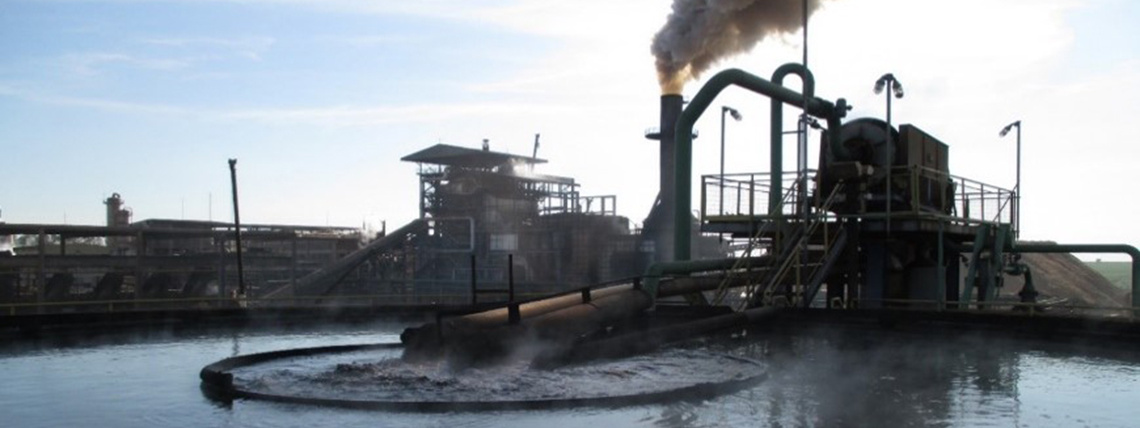The articles of the current edition are available on the new site.

In Brazil and other countries, a lot of water is used, on average, to operate air pollution control systems for particulate matter (usually referred to as PM) called “wet scrubbers”. In these devices, water is nebulised in a column to capture the particles in little water droplets. This system is used, above all, to reduce emissions coming from bagasse-fed steam generators. “Bagasse” is the residue from the industrial processing of sugarcane. The steam and energy obtained using bagasse combustion are needed to operate the sugar and alcohol production plants. However, the wet scrubbers produce sludges that contain harmful substances and, for this reason, must undergo a special treatment, without being disposed as they are.
Dry technologies are available too and they do not require the use of water, which is much more precious than it used to be. These technologies are also able to ensure emissions control. The problems with these innovative techniques include the initial cost of investment and, very often, the consolidated habits that are not questioned, especially because the majority of sugar and alcohol producers are reluctant to innovate.
In an article recently published in the journal “Springer Nature Content Sharing Initiative”, in the “Clean Technologies and Environmental Policy” section, Prof. Paolo Tronville – lecturer in Technical physics of the Environment of the “Galileo Ferraris” Department of Energy at the Politecnico di Torino – together with Prof. Murilo Innocentini – lecturer in Chemical Engineering at the Universidade de Ribeirão Preto – start from the case study of the Brazilian sugarcane industry to illustrate the environmental and economic problems of the “wet scrubbers” system. They provide updated performance indicators and alternatives for optimising a fume-cleaning system to promote a more rational management of clean water and wastewater, with potential savings for the sugarcane industry.
In the article, they demonstrate how the use of water scrubbers may lead to significant losses of water and energy, as well as high operating costs for wastewater treatment plants (WTS).
Brazil, as the largest global producer of sugarcane, was chosen as a case study, using the data of a typical ethanol and sugar production plant in the South American country. The key performance indicators of a steam generator and wet scrubbers were assessed experimentally during a sugarcane harvest season and were compared with the legal requirements for particulate matter emissions and water quality in Brazil. The results highlight the inefficiency of the water-based system, which used only 30% of the water to operate the water scrubbers and 70% to transport the dry particle material collected in the exhaust duct of the steam generator, in the heat exchangers, and in the multi-cyclone separation system.
Evaporation caused the loss of 10.5% of the cleaning water in the atmosphere. Finally, transporting the wet particulate material thus collected (7.9t/h with 78% water inside of it) for disposal in the fields entails significant petrol costs, as well as significant water losses. The inefficiency is also economic: the operation of the wastewater treatment plant accounted for 62% of the total capital expenses of the cleaning system, while the wet scrubbers represented just 38%.
Operation diagram of the Wet Scrubber particulate matter emission removal system with the associated issues
As mentioned, in Brazil and elsewhere “wet scrubbers” have been used for decades to control the particulate matter emitted by steam generators. This choice was justified by their acceptable performance in meeting environmental standards, the abundance of water resources, and their simpler and cheaper operation compared to other dry-cleaning operations. In any case, the progressive tightening of particulate matter emission limits, and the need to more rationally manage water and wastewater in these applications, changed these conditions. Despite the extensive literature on “wet scrubbers”, the lack of updated indicators on their performance in the sugarcane industry has, until now, prevented their optimisation.
Whenever production processes generate hot flue gas flows that need to be cleaned removing particle matter, the analysis of the article may be useful to demonstrate that the use of wet scrubbers causes a loss of energy and water that can be avoided by adopting dry systems.
“Thanks to the results obtained with this study”, Prof. Paolo Tronville comments, “we hope we’ll soon be able to install a pilot plant in Brazil that can demonstrate in practice how it is possible to combine reduced environmental impact and lower operations costs, while maintaining the control of emissions”.
“The partnership between POLITO and UNAERP was essential for demonstrating that managing water used for cleaning the fumes produced by bagasse-fed steam generators is still neglected and uneconomical in the majority of plants producing sugar and ethanol. Thus, thermal energy and water, both precious resources today, are wasted”, Prof. Murilo Innocentini emphasises. “The same problems may occur in all biomass-fed steam generators where water is used to control particulate matter emissions and limit the environmental impact. Our partnership proposes alternatives for implementing and optimising dry fume-cleaning technologies to help industry comply with the PM emissions limits, while obtaining savings in the process. Our intention is to establish a partnership with the industries interested in this optimisation. For example, that could be accomplished by building a pilot plant for testing the dry collectors, or even by re-sizing their wet scrubbers to make them more economical and ecological. POLITO and UNAERP engineers and students are welcome to come on board to face this challenge”.